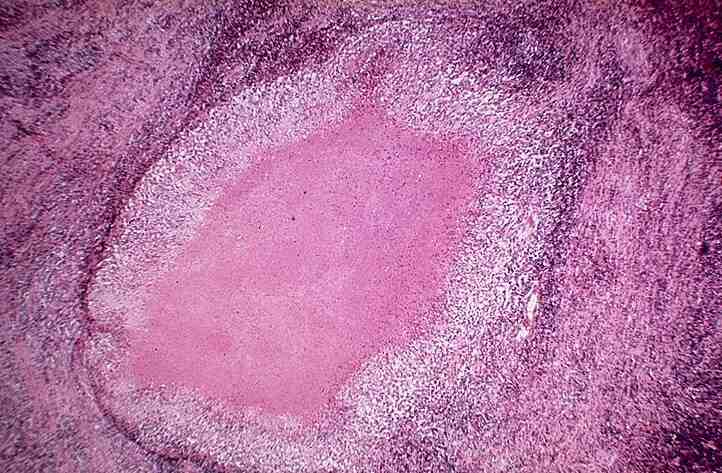
Lymph node TB

Pathology
Report
Lymph
node biopsy. The
lymph node contains numerous granulomas characterised by central caseous
necrosis, surrounded by a zone of epitheloid macrophages.
There are scattered Langhan�s giant cells with myultiple nuclei
arranged in a peripheral pattern.
The small round cells represent lymphocytes.
Ziehl-Neelsen
stain for mycobacteria is positive (special stain).
Diagnosis:
Mycobacterial Infection
1.
What
type of pathologic process is shown?
Granulomatous
inflammation (cell mediated delayed-type hypersensitivity) with caseous necrosis
2.
Name
the most likely aetilogical agent.
Mycobacterium
tuberculosis
3.
What
is the most likely route of entry?
Respiratory
aerosol (i.e. through inhalation of airborne droplets containing this bacteria)
4.
What
other organs are likely to be involved if this lymph node was taken from the
neck?
Lung,
bronchus and trachea.
5.
Explain
the pathogenesis.
What is the cause of the caseation necrosis?
The
macrophages phagocytosed the tubercle bacilli, where they may
initially continue to divide in the macrophage
cytoplasm. Macrophages
present mycobacteria antigens to T cells and initiate a cell-mediated immune
response. Cytokines
released by lymphocytes activate macrophages into epitheloid cells.
Epitheloid cells have enhanced ability to secrete substances to kill
tubercle bacilli.
However, these substances will also kill the normal cells resulting in
caseation necrosis.
6.
Why are giant cells present?
They are present due to the fusion of the epitheloid cells.
In this case these giant cells are Langhan�s
giant cells. They
help to wall off the tubercle bacilli from surrounding
susceptible tissue and also release substances to aid in
the extracellular killing of the tubercle bacilli.
7.
How
would you confirm the aetiology?
By
using special stain for acid fast bacillus Z-N stain.
8.
What
are other causes of granulomas?
Unknown � sarcoidosis (Crohn�s disease) -
affects many organs
Infection � some bacteria/parasite, fungi etc -
TB, Leprosy
Inorganic foreign particles � silica, talc, asbestos, oils, beryllium
Organic foreign particles � pollens, grass seeds, mushroom spores, etc
<< PREVIOUS INDEX NEXT SLIDE >>
Copyright � Joseph Ong 2003